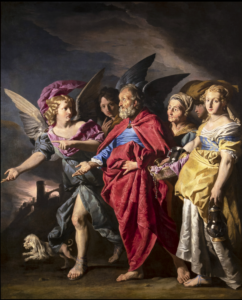Object of the Month: May 2024
The Flight from Sodom
Oil on canvas, c. 1630
Matthias Stomer
Dutch, c. 1600–after 1649
Very little is known about the artistic training of Dutch master Matthias Stomer. His works have similarities to Gerrit van Honthorst and Abraham Janssens, both in M&G’s collection. He spent some time in Rome being influenced by Caravaggio as did many of his contemporary fellow artists. He seems to have settled in Sicily and painted many biblical subjects. Though some think M&G’s The Flight from Sodom is derivative of a Rubens’ work of the same title at the Ringling in Sarasota, Florida, Stomer simply tells the “rest of the story.”
Genesis 19 reveals that the escape of Lot and his family from Sodom has two stages. First, God warns Lot of the impending destruction of Sodom for its immorality and wickedness and tells him to gather his family and escape the fate of the city. Unfortunately, his efforts are rebuffed by his sons-in-law. The delay means he is still in the city at daybreak. Then he is commanded, “Escape for thy life; look not behind thee, neither stay thou in all the plain; escape to the mountain.” But in fear, Lot begs to escape to a “little” city nearby rather than the mountain of God’s dictum. God mercifully allows this change, saving Zoar from destruction for Lot’s sake.
Stomer paints the second part of the drama: Lot’s negotiating his escape into Zoar. Lot’s wife is near the back of the group, signifying her growing reluctance to leave. Her faraway gaze shows her preoccupation with the past. She will eventually look back and be turned into a pillar of salt as punishment. In the foreground the blond daughter carries a basket of gold household items and engages the audience with a direct gaze. Is she asking for sympathy? For approval of her father’s plan? She definitely challenges the viewer to contemplate the event. The other daughter, mostly hidden, carries a cloth bundle on her head. She gazes straight ahead, intent on escaping with her life.
Lot clutches his red robe to him. Is he facilitating his gait or visually showing his reluctance to leave by grasping the rich garment that indicates his prominence? His raised eyebrows indicate a question for the leading angel. His open left palm indicates that the question asked is reasonable, almost a “what about?” gesture. The lead angel looks astonished at the request, mirroring Lot’s hand position with one hand while pointing definitively forward with the other, as if to say, “You want to go there?” The second angel’s hand lies near his chin, like the professor’s “stroking his beard” as he considers a student’s idea. Lot suggests a change of plan, and the angels seem to have differing opinions on it.
It may be reading too much into the painting to see in the half-shaved little dog a lesson that Lot and his family are escaping by the “skin of their teeth.” However, the running dog has more sense than Lot who has dawdled at every turn of the story, even with his life at stake. Stomer’s background indicates that the family has taken all night to leave the city (Genesis 19:16 states that the angels had to “set him without the city”). The morning has come—the time when Lot finishes his “flight” since “the sun was risen upon the earth when Lot entered into Zoar” (19:23). Ironically, even Stomer doesn’t finish the story. Lot and his daughters eventually find Zoar inhospitable, and the evil that Lot dreaded “in the mountain” comes to pass.
Dr. Karen Rowe Jones, M&G board member
Special Note:
Scholars have discovered that Stomer used “Naples yellow,” a color created by combining antimony and lead. First mentioned in the late 17th century, Naples yellow appears in Stomer’s early work. Determining whether the blond daughter’s robe uses Naples yellow, might facilitate dating The Flight from Sodom within Stomer’s oeuvre.
Botticelli, Michela, Costanza Miliani, Eva Luna Ravan, Claudia Caliri, and Francesco Paolo Romano. 2024. “Naples Yellow Revisited: Insights into Trades and Use in 17th-Century Sicily from the Macro X-ray Fluorescence Scanning of Matthias Stomer’s ‘The Mocking of Christ’” Heritage 7, no. 3: 1188-1201. https://doi.org/10.3390/heritage7030057
Published 2024
